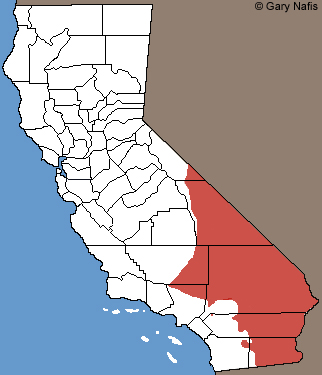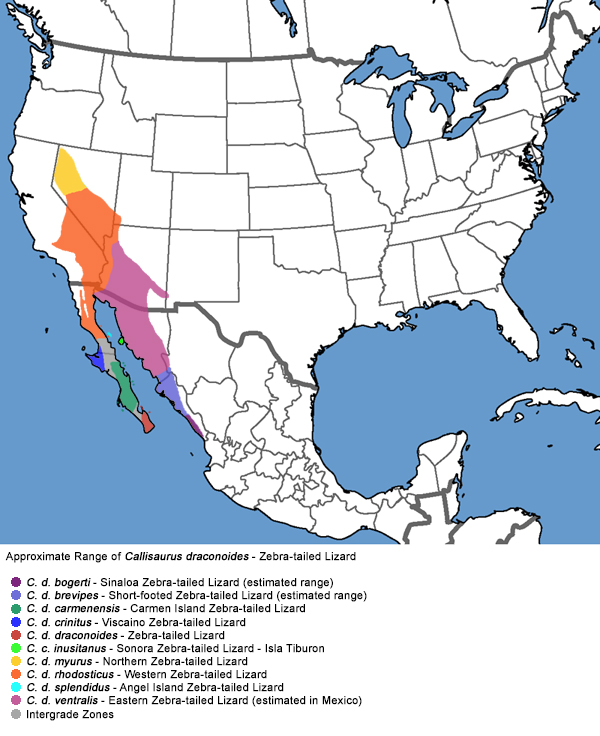Zebra-tailed Lizard - Callisaurus draconiodes
Western Zebra-tailed Lizard - Callisaurus draconoides rhodostictus
Cope, 1896Description • Taxonomy • Species Description • Scientific Name • Alt. Names • Similar Herps • References • Conservation Status
 |
|||||||||||||||||||||||||||||||||||||||||||||||||||||||
| (Non-breeding season) adult male, Kern County | |||||||||||||||||||||||||||||||||||||||||||||||||||||||
 |
|||||||||||||||||||||||||||||||||||||||||||||||||||||||
| Breeding adult female, Kern County | |||||||||||||||||||||||||||||||||||||||||||||||||||||||
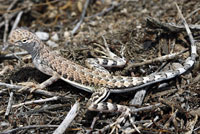 |
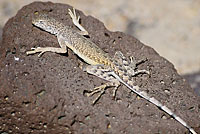 |
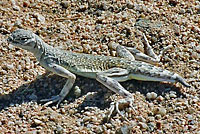 |
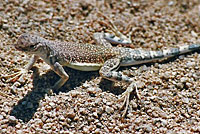 |
||||||||||||||||||||||||||||||||||||||||||||||||||||
| Adult female, Kern County | Adult female, Kern County | Adult female, Kern County, missing the end of her tail. | Adult male, San Bernardino County, showing no stripes on the underside. | ||||||||||||||||||||||||||||||||||||||||||||||||||||
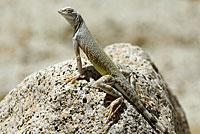 |
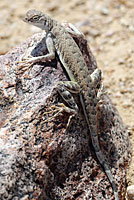 |
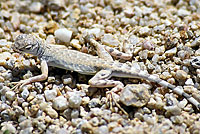 |
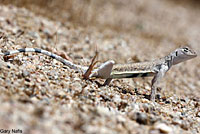 |
||||||||||||||||||||||||||||||||||||||||||||||||||||
| Adult male, San Diego County | Adult female, Kern County | Juvenile, Kern County | Adult male, Kern County | ||||||||||||||||||||||||||||||||||||||||||||||||||||
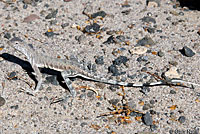 |
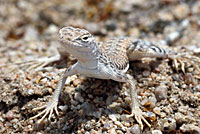 |
 |
 |
||||||||||||||||||||||||||||||||||||||||||||||||||||
| Adult male from dark lava flow area, San Bernardino County |
Adult female, Kern County | Adult male, San Diego County © Bruce Edley |
Adult male, San Bernardino County © Brad Alexander |
||||||||||||||||||||||||||||||||||||||||||||||||||||
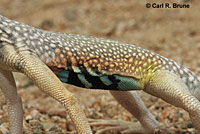 |
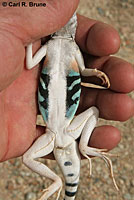 |
 |
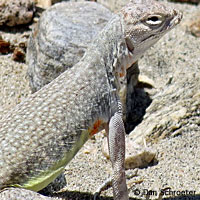 |
||||||||||||||||||||||||||||||||||||||||||||||||||||
| Adult male, Inyo County. © Carl R. Brune. Males typically have two dark stripes on the sides and undersides, but this unusual male has three dark stripes. | Adult female, Riverside County © Dan Schroeter | ||||||||||||||||||||||||||||||||||||||||||||||||||||||
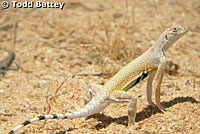 |
 |
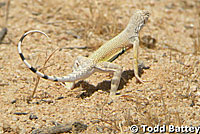 |
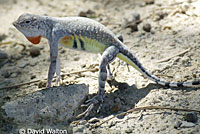 |
||||||||||||||||||||||||||||||||||||||||||||||||||||
| Adult male, Kern County © Todd Battey | Adult male in threat display, Clark County Nevada © David Walton |
||||||||||||||||||||||||||||||||||||||||||||||||||||||
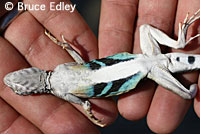 |
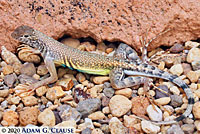 |
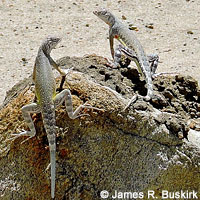 |
 |
||||||||||||||||||||||||||||||||||||||||||||||||||||
| Underside of adult male, San Diego County © Bruce Edley |
Young adult male, Mono County © Adam G. Clause |
Adult male (left) and female (right) Riverside County © James R. Buskirk | |||||||||||||||||||||||||||||||||||||||||||||||||||||
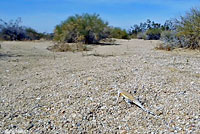 |
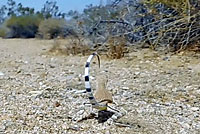 |
 |
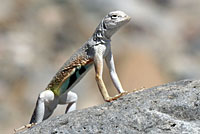 |
||||||||||||||||||||||||||||||||||||||||||||||||||||
| Adult, Kern County | As you can see on this adult female in Kern County, when running, zebra-tailed lizards raise up and wave their tail to show the zebra-like black and white bars on the bottom of the tail. This draws the predator's attention to the more expendable tail and away from the vulnerable body. | Adult male, Inyo County. Zebra-tailed lizards are very tolerant of extreme heat. The air temperature was 100 degrees F. when this lizard was seen out in the sun on top of a rock. The temperature of the rock was 130 degrees F. ! (54.44 C.) |
|||||||||||||||||||||||||||||||||||||||||||||||||||||
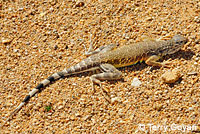 |
 |
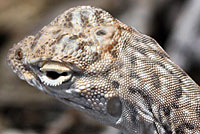 |
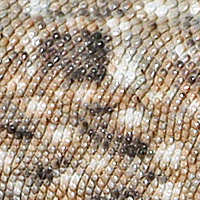 |
||||||||||||||||||||||||||||||||||||||||||||||||||||
| Adult male, San Bernardino County © Terry Goyan |
Adult male, San Bernardio County © Zeev Nitzan Ginsburg |
Adult female, Kern County This close-up shows the fringed protective scales around the eyes, the third eye on top of the head, and the ear on side of the head behind the eye (which can help differentiate a zebra-tailed lizard from a similar earless lizard.) |
Zebra-tailed Lizards, genus Callisaurus, have smooth granular scales on their upper sides. |
||||||||||||||||||||||||||||||||||||||||||||||||||||
| Habitat | |||||||||||||||||||||||||||||||||||||||||||||||||||||||
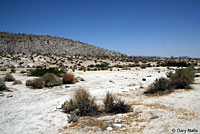 |
 |
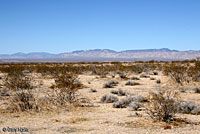 |
 |
||||||||||||||||||||||||||||||||||||||||||||||||||||
| Habitat, sandy wash, San Diego County | Habitat, sandy wash during a good spring wildflower bloom (1998), Riverside County |
Habitat, Kern County | Inland habitat, creek flowing out of San Gabriel Mountains near Cajon Pass, Riverside County | ||||||||||||||||||||||||||||||||||||||||||||||||||||
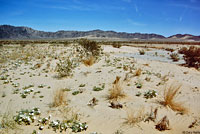 |
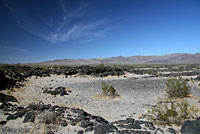 |
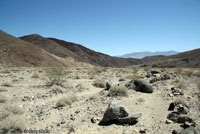 |
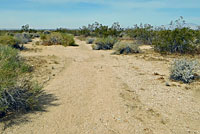 |
||||||||||||||||||||||||||||||||||||||||||||||||||||
| Habitat, windblown sand and sandy wash, San Bernardino County |
Habitat, lava flow, San Bernardino County |
Habitat, rocky wash, Inyo County | Habitat, Kern County | ||||||||||||||||||||||||||||||||||||||||||||||||||||
| Short Videos | |||||||||||||||||||||||||||||||||||||||||||||||||||||||
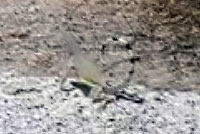 |
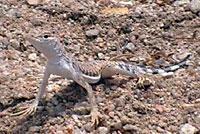 |
 |
|||||||||||||||||||||||||||||||||||||||||||||||||||||
| This video shows several views of zebra-tailed lizards from the Colorado Desert in San Diego County, waving their striped tails to divert attention away from their main body, running off quickly, and doing the territorial push-up display. | One early afternoon during a summer cold front in the Mohave Desert in Kern County, I was able to get close to several zebra-tailed lizards and follow them around as they moved relatively slowly compared to how fast they move when it's hot. | On a late spring day in Kern County I followed this zebra-tailed lizard around its sandy wash habitat. Most zebra-tails run away as fast as they can, but this one seemed curious of the large hairless ape with a funny hat crawling on its knees and only ran a short distance then stopped, allowing me to approach her closely again. But she still exhibits the flight behavior typical of this species - wagging her striped tail as a distraction from her body, and even doing a push-up display warning me not to come any closer. | |||||||||||||||||||||||||||||||||||||||||||||||||||||
|
|||||||||||||||||||||||||||||||||||||||||||||||||||||||
|
|||||||||||||||||||||||||||||||||||||||||||||||||||||||
|
The following conservation status listings for this animal are taken from the July 2025 State of California Special Animals List and the July 2025 Federally Listed Endangered and Threatened Animals of California list (unless indicated otherwise below.) Both lists are produced by multiple agencies every year, and sometimes more than once per year, so the conservation status listing information found below might not be from the most recent lists, but they don't change a great deal from year to year.. To make sure you are seeing the most recent listings, go to this California Department of Fish and Wildlife web page where you can search for and download both lists: https://www.wildlife.ca.gov/Data/CNDDB/Plants-and-Animals. A detailed explanation of the meaning of the status listing symbols can be found at the beginning of the two lists. For quick reference, I have included them on my Special Status Information page. If no status is listed here, the animal is not included on either list. This most likely indicates that there are no serious conservation concerns for the animal. To find out more about an animal's status you can also go to the NatureServe and IUCN websites to check their rankings. Check the current California Department of Fish and Wildlife sport fishing regulations to find out if this animal can be legally pursued and handled or collected with possession of a current fishing license. You can also look at the summary of the sport fishing regulations as they apply only to reptiles and amphibians that has been made for this website. This animal is not included on the Special Animals List, which indicates that there are no significant conservation concerns for it in California. |
||
| Organization | Status Listing | Notes |
| NatureServe Global Ranking | ||
| NatureServe State Ranking | ||
| U.S. Endangered Species Act (ESA) | None | |
| California Endangered Species Act (CESA) | None | |
| California Department of Fish and Wildlife | None | |
| Bureau of Land Management | None | |
| USDA Forest Service | None | |
| IUCN | ||
|
|
||
Return to the Top
© 2000 -

